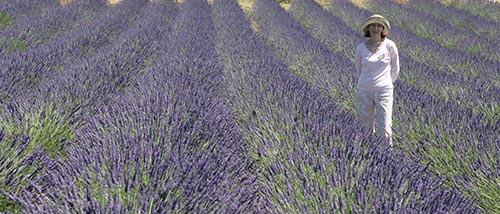

Most women who are going to buy a cosmetic cream rely on advertisements, friend's suggestions or price range, while those more curious read the label. What we actually see on the label is so confusing. Nobody knows or understands chemical names, and we question why it is necessary to put all this stuff into the cream and use it on our faces.
Historically, cosmetic creams were made of just a few ingredients and according to Dr. Galen's old recipe: olive oil, water, beeswax and rose petals were good enough to satisfy Roman beauties in ancient Rome 2000 years ago. My lucky day and the turning point in my "cosmetic thinking" happened when I found a similar cream made by a Swiss company. Soon I learned more about natural cosmetics and began to make them. The most important factor which helped me make a rational decision about cosmetics was understanding the physiology of the skin or, in other words, what our skin really needs. I think Dr. Galen was right, the more natural and simpler, the better.
Briefly speaking, our skin is composed of three layers known as epidermis, dermis (true skin) and subcutis. The most outer part of epidermis is shed regularly, and the deeper layers contain actively growing new cells. They need nutrients such as amino acids, fats, water and vitamins, which could be supplied from our diet and possibly delivered by cosmetics for the surface of the skin. Normally, healthy skin is covered by so called "hydrolipid layer". This is an emulsified mixture of watery secretions from sweat glands (apocrine glands) and fatty (lipid) secretion from sebaceous glands. This natural barrier regulates water contents, lubricates and supples the skin, isolates against temperature changes, and also prevents microorganisms and viruses from entering. Sometimes, due to many reasons, this layer is not properly formed, and we need to supply what is missing in a form of a lotion or a cream.
Cosmetic creams and lotions are based on the same principle. Considered as emulsions, they are stable mixtures of oil phase dispersed in water. Depending on components used for preparation of a cream, they might be divided into three groups: completely synthetic, 100% natural, and containing both types of ingredients.
Most cosmetic creams found on the market contain fats, synthetic emulsifiers, preservatives and synthetic fragrances that cannot be utilized by human cells because they are foreign to our body. That kind of cream can form an occlusive barrier protecting the body from cold or heat but it does not nourish the cells. Some components may even be harmful.
Aubrey Hampton and other "naturally oriented" cosmetic chemists, herbalists, and natural skin care estheticians advise to avoid in cosmetics components such as: paraffin, vaseline, petrolatum, mineral oil (fat phase) and synthetic emulsifiers like PEG (polyethylene glycol), DEA and TEA (di- and triethanolamine). Preserving agents, very often used and known as parabens, (methyl-, propyl-, butyl-, ethyl-) should also be avoided because of their toxicity. Manufacturers of cosmetics using those components probably do not agree with the above opinion, and claim that we do not have enough evidence for toxicity etc. Regardless of who is right, most of us do not want to be a guinea pig, and if we had a choice, probably we would pick the more safe and healthy solution. Only a small percentage of cosmetics found on the market are based exclusively on natural ingredients, but demand for them is increasing with more conscious, health-oriented customers.
From the chemical analysis of hydrolipid layer naturally occurring on surface of the skin, we know that its most common components are triglycerides and fatty acids emulsified by cholesterol and phospholipids with water. These kinds of substances are found in vegetable oils such as olive, avocado, sunflower, safflower, and almond oils, and they are very good bases for natural creams. Components of vegetable oils known as essential fatty acids such as oleic, linoleic and linolenic are structural elements of cell membranes, and their deficiency in a diet can cause all sort of skin and health problems.
Natural emulsifiers and consistency agents used in creams may come from natural sources existing in nature such as soy or egg lecithin, lanolin, beeswax, cocoa butter or shea butter. Most of them are beneficial for skin metabolism and the quality of a cream. The most wonderful gifts of nature, which could be employed in natural skin care, are botanical extracts and essential oils - plants' natural fragrances. Essential oils are extracted mostly by distillation of plant material from petals, leaves, stems, roots or bark, and collected in a very concentrated form. Oil from one plant may be a mixture of over one hundred different components belonging to chemical classes of ethers, esters, alcohols, ketons or others. Composition of oil determines its physical and therapeutic properties. Essential oils of rose, lavender, geranium, jasmine, chamomile sandalwood, myrrh, frankincense, and ylang ylang are excellent for natural skin care products. Along with vegetable oils, they can rejuvenate the skin by speeding up formation of new cells, help heal scars and diminish wrinkles. Because their molecules are very small, they can penetrate the deeper layers of the skin. Essential oils designated for therapeutic use should be in pure, natural, unadulterated form and used in a specific concentration. Other benefits coming from using essential oils in cosmetics are pleasant natural fragrances and stabilizing effect on the product due to their antiseptic properties.
Barbara Rychlik
Founder of Ms. Lavenda
Suggested Reading
1. A. Hampton (1987) Natural Organic Hair
and Skin Care, Organica Press.
2. A. Hampton (1995) What is in Your Cosmetics, Odonian
Press.
3. J. Lawless (1992) The Encyclopaedia of Essential Oils,
Element.
4. S. Tourles (1999) Naturally Healthy Skin, Storey
Books.
5. S. Battaglia (2002) The Complete Guide to Aromatherapy, The International Centre of Holistic Aromatherapy
6. N. Purchon & L. Cantele (2014) The Complete Aromatherapy & Essential Oils Handbook for Everyday Wellness, Robert Rose Inc.
7. J. Buckle (2015) Clinical Aromatherapy, Elsevier.
